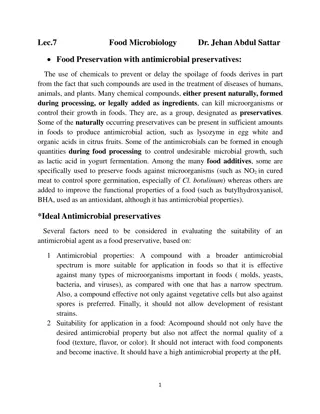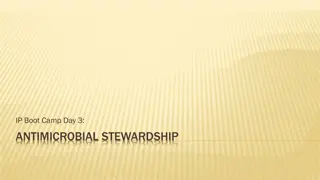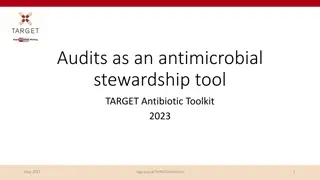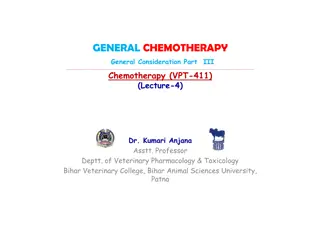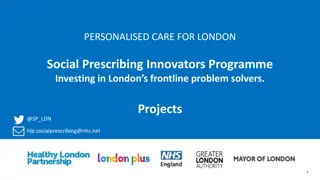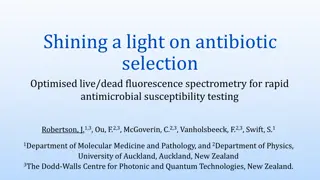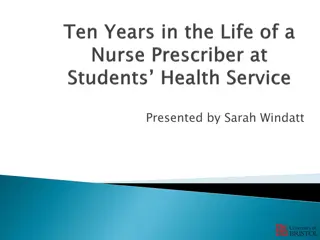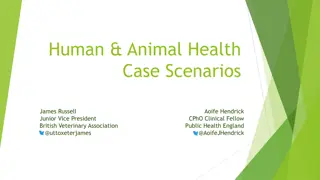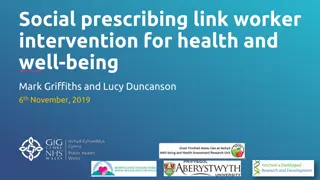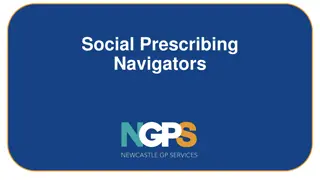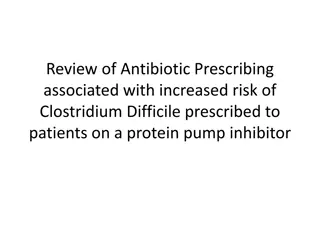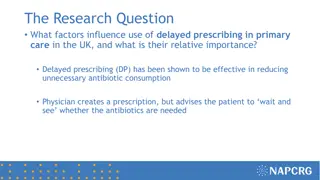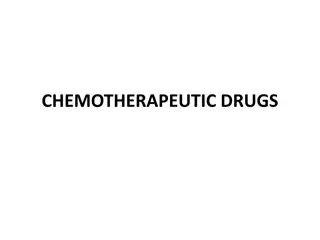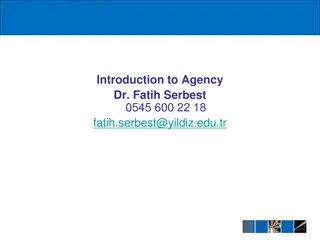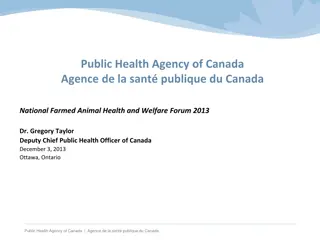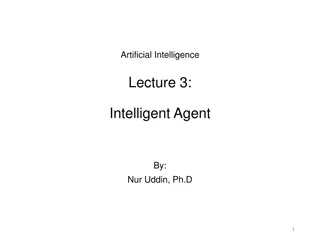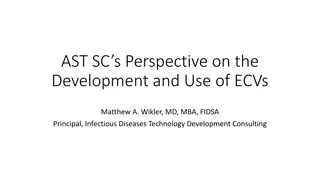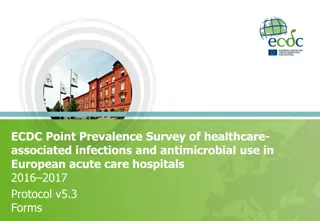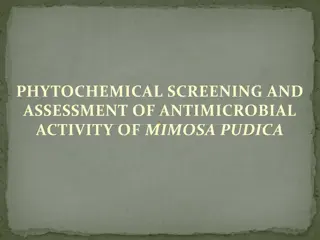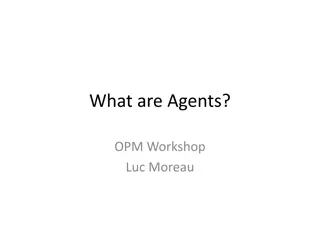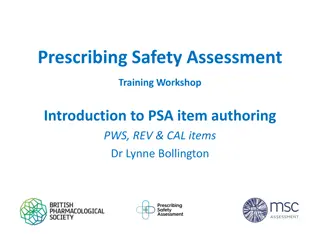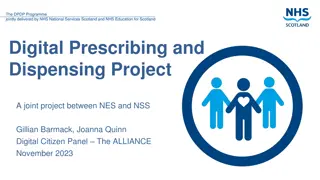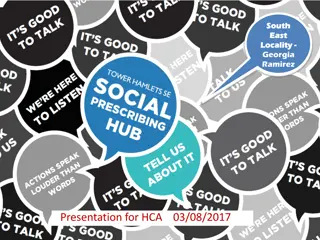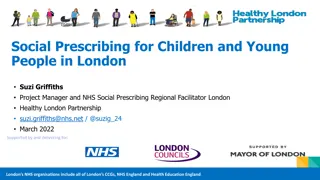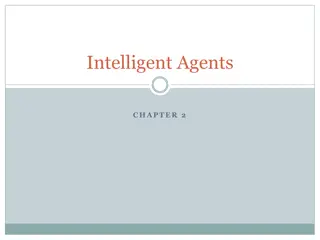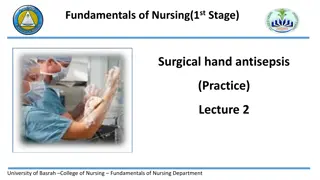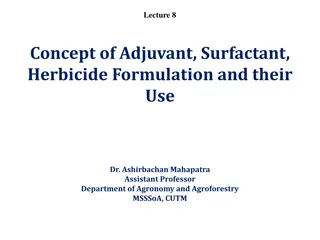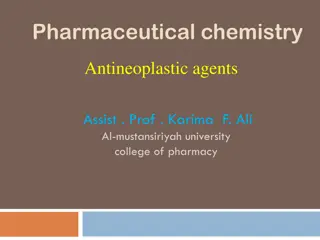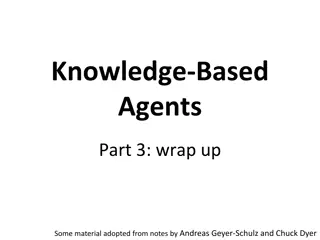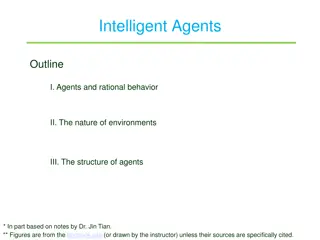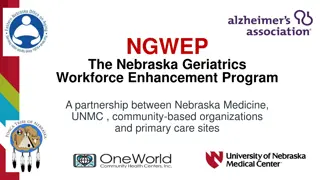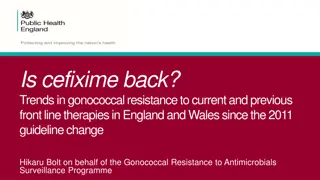Challenges in Prescribing the Right Antimicrobial Agents
Prescribing the appropriate antimicrobial medication can be a daunting task due to various factors. In this case discussion, the patient is on multiple medications for different conditions, making it essential to carefully consider the choice of antimicrobial. Factors such as drug interactions, patient's medical history, and susceptibility patterns play a crucial role in ensuring effective treatment and preventing antimicrobial resistance.
Download Presentation

Please find below an Image/Link to download the presentation.
The content on the website is provided AS IS for your information and personal use only. It may not be sold, licensed, or shared on other websites without obtaining consent from the author. Download presentation by click this link. If you encounter any issues during the download, it is possible that the publisher has removed the file from their server.
E N D
Presentation Transcript
Why prescribing the right antimicrobial can be a pain in the neck.. N PETERS R SUTHERLAND REGIONAL INFECTIOUS DISEASES UNIT EDINBURGH
Case Discussion Medications: Lansoprazole 30 mg Alendronic acid 70 mg once weekly Adcal D3 1 tablet bd Lisinopril 10 mg daily Simvastatin 40 mg daily Co-tenidone 100/25 mg Cocodamol prn. 84-year old female Background of - Hypertension - Hypercholesterolaemia
Case Discussion Presented initially to Rheumatology clinic in July 2017 - 5-month history of right-sided headache - Scalp tenderness / temporal tenderness - Likely diagnosis?
Case Discussion Presented initially to Rheumatology clinic in July 2017 - 5-month history of right-sided headache - Scalp tenderness / temporal tenderness - Commenced initially on high-dose prednisolone (40 mg OD) - Temporal artery biopsy arranged - Provisional diagnosis of temporal arteritis.
Case Discussion No response to oral prednisolone after one month. Biopsy negative. Re-discussed with Rheumatology and urgent CT head arranged: Partially imaged right nasopharyngeal mass causing obstruction of the right eustachian tube and extending into the adjacent soft tissues and sinuses, with bony erosion Referred to ENT who proceeded to perform an examination under anaesthesia of the inflammatory mass in the post-nasal space
MRI head showing right base of skull inflammatory changes
Case Discussion Inflammatory mass seen in postnasal space on examination under anaesthesia. Likely aetiology? Likely pathogens? Where would you manage the pt? Under whose care? Antimicrobial therapy? For how long?
Case Discussion Inflammatory mass seen in postnasal space on examination under anaesthesia. Grommet inserted to right ear Pus found in middle ear CT chest and neck had been requested which showed a 6cm heterogenous left upper abdominal soft tissue mass, closely applied to spleen and proximal stomach Could this change the differential?
What tx would you commence? After sampling Cover pseudomonas and MSSA Depend on local microbiology and sensitivities CNS penetration of antimicrobials
What tx would you commence? Pt returned from theatre and ciprofloxacin ear drops commenced .
What tx would you commence? Pt returned from theatre and ciprofloxacin ear drops commenced Discussed with microbiology on call who advised vancomycin and meropenem iv
What tx would you commence? Pt returned from theatre and ciprofloxacin ear drops commenced Discussed with microbiology on call who advised vancomycin and meropenem iv Initial results from swab from theatre- E coli (amox sens) and MSSA (sens clari and flucloxacillin) Lot of discharge from grommet on RHS
What tx would you commence Day 7 post op- phone call from microbiology- sample from theatre, labelled sphenoid swab, has grown a mould consistent with Aspergillus sp The biopsy from theatre (post nasal space) showed granulomatous inflammation and fungal hyphae What would you advise now?
What tx would you commence Day 7 post op- phone call from microbiology- sample from theatre, labelled sphenoid swab, has grown a mould consistent with Aspergillus sp The biopsy from theatre (post nasal space) showed granulomatous inflammation and fungal hyphae What would you advise now? Our microbiology dep advised adding in voriconazole iv 2 weeks into tx- decision to stop vancomycin and continue voriconazole and meropenem for 6 weeks initially PICC line inserted, transferred to infectious diseases ward from ENT ward
Data on fungal ID and sensitivities Initial swab: Small number of mould isolated Later, Aspergillus identified. Sent to reference laboratory, Bristol, who supplied following report: -Aspergillus Fumigatus Poorly Sporing variety. MIC results in mg/L Amphotericin B Caspofungin Itraconazole Voriconazole Sensitive Sensitive Sensitive Sensitive MIC 0.05 MIC 0.03 MIC 0.5 MIC 1
Case Discussion - Treatment 27/10/17 transferred to infectious diseases ward Investigated abdominal mass- likely GIST Gastro intestinal stromal tumour Endoscopy and biopsy- benign- observe and re scan in 6 months Trained husband to administer meropenem at home- but he felt unable to take this on Inpatient for 6 weeks of mero and po vori Repeat MRI no significant improvement- if anything worsening of bone enhancement Thoughts? Discharged 17/11/2017 with ciprofloxacin 750 mg BD to complete 3 months in total gram negative cover Plus voriconazole 300 mg BD. Planned treatment course with antifungals of 1 year.
Data on voriconazole levels Date Level (Trough aiming for 1.3-5.7 mg/L) 27/10/17 02/11/17 23/11/17 30/11/17 14/12/17 04/01/18 11/01/18 25/01/18 01/02/18 08/02/18 15/02/18 22/02/19 4.08 2.98 0.51 1.07 1.09 1.17 0.92 2.86 3.02 3.36 4.26 2.51
Counselling the patient before long term antimicrobials What possible adverse effects do we inform the patient of?
Drug safety update on Voriconazole in 2014 1 yellow card of hepatic disorder and 3 yellow cards of skin disorders resulted in manufacturer distributing tools to increase awareness for prescribers Advice wrt liver function- check LFTS before starting, weekly for 1 month and monthly thereafter if no change Phototoxicity and squamous cell carcinoma: Tell pts to avoid sunlight exposure, check skin regularly and refer to dermatology if concern
Case discussion Week 20 of treatment Developed musculoskeletal pains, affecting especially her upper torso with shoulder girdle pains. LFTs became increasingly deranged What are possible causes?
At first ciprofloxacin was stopped after the GP rang the infection consultant for advice The pt was thought that the pt had received a long enough course of this antimicrobial anyway and that the muscle and shoulder pain could be a possible symptom of a quinolone associated tendonitis Unfortunately the symptoms did not settle The pt was referred to rheumatology by her GP in case there was an alternative diagnosis to explain these now significant joint and muscle symptoms
Voriconazole levels correlating with side effects and LFTs Case discussion 4.5 4 3.5 3 Voriconaz The pt was reviewed in the ID OPD 2.5 2 1.5 1 Still experiencing musculoskeletal pains, affecting especially her upper torso with shoulder girdle pains. LFTs increasingly deranged 0.5 0 Treatment switch date 300 250 200 Decision to stop the voriconazole 150 Bilirubin 100 ALT ALP 50 0
What treatment should be given now? Is stopping altogether an option? The MRI shows that the inflammatory mass is no smaller and bony enhancement possibly worse What anti fungal options are there now?
Azole antifungal agents Triazole group consists of along with fluconazole, itraconazole, posaconazole, voriconazole, isavuconazole Fluconazole has good action against yeasts, but not moulds Itraconazole provides broader spectrum but has inconsistent bioavailability Voriconazole is first line for invasive Aspergillus infection but has unique side effects such as vision changes, photosensitivity and periostitis Posaconazole and isavuconazole have broadest spectrum of activity Posaconazole association with muscle cramps as well
Mrs C and Voriconazole Approximately 4 months after commencing voriconazole Mrs C began to experience musculoskeletal pain. Potential side effect of ciprofloxacin or voriconazole Stopping ciprofloxacin had no effect Soon after voriconazole, switched to isavuconazole. Both shoulder girdle pain and LFTs improved - Rare but well-documented side effect of long-term voriconazole is periostitis caused by effects on fluoride accumulation - Voriconazole is strong inhibitor of CYP3A4, simvastatin continued at reduced dose. Isavuconazole is mild inhibitor of CYP3A4
Isavuconazole - Pharmacology Triazole antifungal agent - Blocks synthesis of ergosterol and therefore damages fungal cell wall Can be given intravenously or orally. 98% bioavailability when taken orally Prodrug- isavuconazonium sulphate Mild inhibitor of CYP3A4, many other triazole antifungals are strong inhibitors. Dependent upon CYP3A4 for metabolism, therefore prone to drug-drug interactions as with other triazoles Prolonged half life (130 hours), allowing once daily dosing after a 2-day TDS loading regime. Good penetration of tissues volulme of distribution 450 Litres
Isavuconazole Adverse effects Hepatotoxicity, along with other triazole antifungals Nausea, vomiting, diarrhoea are most common side effects along with hypokalaemia, headaches along with other triazole antifungal agents. Appear to be less common than with voriconazole Infusion reactions are more prominent than with other triazole antifungals
Isavuconazole - literature SECURE trial, Maertens et al, Lancet 2016 compared efficacy and safety of isavuconazole vs voriconazole in invasive mould disease found reduced drug-related side effects in those treated with isavuconazole Van Matre et. Al, Ann Clin Microbiol Antimicrob 2019 found isavuconazole associated with fewer composite safety outcomes compared with voriconazole or posaconazole. No difference in LOS, mortality, readmission or infection recurrence
Isavuconazole Expensive. 42.80 per day of treatment. - Voriconazole is 6.95 per day of treatment, excluding therapeutic drug monitoring 1 year of treatment for Mrs C, substantial price difference but symptom free and improved imaging MRI March 2019: Persistent abnormality right central skull base but improved compared with May 2018
Thank you Any questions?



